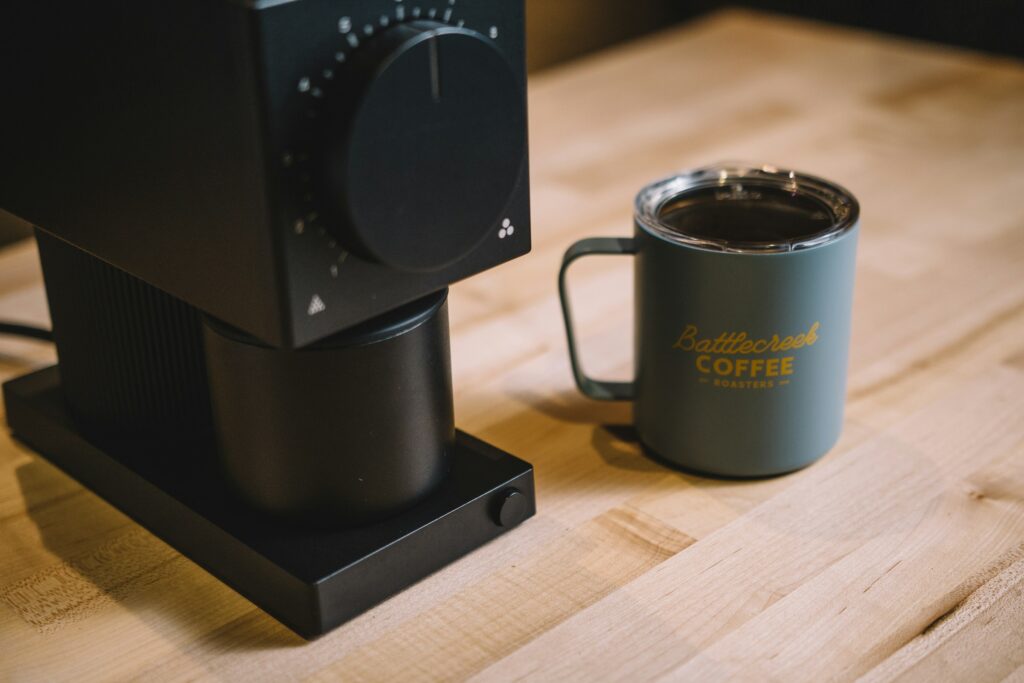You roll out of bed, make your coffee, and take that first sip—only to be met with a cup that tastes flat and dull.
It’s disappointing, especially when you know good coffee can taste alive, rich, and full of character.
The truth is, your grinder has more power over your cup than most people realize. Fresh grounds, consistent size, and even extraction are what separate a “meh” brew from a “wow” brew.
That brings us to the big question: Is it worth spending more on a burr grinder, or is a cheap blade grinder good enough? Let’s find out!
The Short Answer: Yes, a burr grinder is worth the price if you value flavor and consistency. It grinds beans evenly, preserves aromas, and works for all brewing methods.
While more expensive than blade grinders, it delivers café-quality coffee and lasts longer, making it a smart long-term investment.
Why Grinding Matters in Coffee
Freshly Ground vs. Pre-Ground Coffee
Think of coffee beans as little flavor vaults. Once they’re ground, the clock starts ticking. Oxygen rushes in, oils evaporate, and the aroma you love fades fast.
Pre-ground coffee often tastes flat because most of its character disappears before it even hits your mug.
Grinding fresh, on the other hand, lets you capture the full aroma and complexity right before brewing.
It’s the difference between opening a fresh loaf of bread versus eating a slice that’s been sitting out for days.
Key takeaway: fresh grounds = fresher taste, more aroma, and more satisfaction.
How Grind Size Impacts Flavor Extraction
Brewing coffee is basically controlled water chemistry. The size of your coffee particles determines how water interacts with them.
Too coarse and water slips through without pulling out enough flavor—hello, weak and watery coffee. Too fine and water lingers too long, dragging out bitterness you didn’t ask for.
Different brewing methods demand different grind sizes:
- French press → coarse, chunky grind
- Pour-over → medium grind, like sea salt
- Espresso → very fine, almost powdery grind
When grind size matches the brewing style, you unlock balance—sweetness, acidity, and body all play nicely together.
Miss the mark, and your cup can turn sour, bitter, or just plain boring.
Importance of Consistency in Grind Size
Here’s where grinders really earn their keep. Imagine trying to cook pasta with noodles all different lengths—some bite back while others fall apart.
Coffee is no different. If your grounds are a mix of fine dust and chunky boulders, you’ll end up with a confused cup: part over-extracted and bitter, part under-extracted and weak.
Consistency gives you control. It ensures every particle brews at the same pace, leading to a balanced, predictable flavor.
Burr grinders excel at this because they crush beans evenly instead of chopping them randomly like blade grinders. That uniformity is why serious coffee drinkers swear by them.
Types of Coffee Grinders
Blade Grinders
Blade grinders are the entry-level option most people start with. They work like tiny food processors—two spinning blades chop beans into smaller pieces.
The longer you hold the button, the finer the grind gets. Sounds simple, right?
The problem is, they don’t actually grind; they smash. This leaves you with a chaotic mix of powdery dust and chunky bits.
And when hot blades spin at high speeds, they generate heat, which can burn delicate coffee oils before you even brew.
Pros of Blade Grinders:
- Affordable—often $15–$30
- Small and easy to store
- Fast and convenient
- Found in most kitchen stores
Cons of Blade Grinders:
- Inconsistent particle sizes = uneven extraction
- Heat buildup can dull flavors
- No grind setting options, just guesswork
- Short lifespan compared to burr grinders
In short, blade grinders are fine if you’re just dipping your toes into home brewing, but they can quickly become the bottleneck in your coffee journey.
Burr Grinders
Burr grinders are where things get serious. Instead of blades, they use two abrasive surfaces, called burrs, that crush beans into uniform particles.
You can adjust the burrs to control the grind size, from coarse chunks for French press to fine powder for espresso.
There are two main designs:
- Flat burrs: Known for precision and uniformity. Popular with espresso enthusiasts.
- Conical burrs: Quieter, less messy, and usually cheaper than flat burr models. Great all-rounders.
Because burrs grind evenly and gently, they protect the bean’s natural oils and aromas.
That means richer, more consistent cups every time.
Pros of Burr Grinders:
- Consistent grind size = balanced flavor
- Wide range of grind settings for different brew methods
- Longer lifespan and sturdier build quality
- Preserves delicate aromas and oils
Cons of Burr Grinders:
- Higher upfront cost (often $100–$400+)
- Larger footprint on your counter
- Need regular cleaning and maintenance
- Some models can be noisy
If you’re serious about coffee, a burr grinder is like upgrading from a flip phone to a smartphone.
Both can make a call, but only one unlocks the full experience.
The Case for Burr Grinders
Here’s where burr grinders truly earn their reputation.
The biggest selling point is flavor: consistency in grind size means your espresso pulls evenly, your French press avoids sludge, and your pour-over shines with balanced sweetness instead of sourness or bitterness.
Every brewing style has its sweet spot, and burr grinders let you hit it every time.
Beyond taste, they’re built to last—sturdy motors, solid burrs, and better materials mean they won’t burn out after a year like cheap blade models often do.
Versatility is another win: whether you want coarse grounds for cold brew, medium for drip, or ultra-fine for espresso, a burr grinder adjusts with precision, no guesswork required.
And while the upfront price can sting, the long-term math works out; investing once in a reliable burr grinder saves you from constantly replacing cheaper gear, and every cup you brew at home instead of buying at a café pays it back faster than you’d think.
The Downsides of Burr Grinders
Of course, burr grinders aren’t all sunshine and crema, and there are some trade-offs worth mentioning.
The most obvious is the price tag; dropping $100 or more on a grinder can feel steep, especially when a blade grinder costs a fraction of that.
Then comes the learning curve: figuring out the right grind size for espresso versus French press can feel like cracking a safe, with lots of trial and error before you nail it.
They’re also bulkier, so if your kitchen counter already looks like a game of Tetris, squeezing in another appliance might be a headache.
And let’s not forget the noise because some models roar like jet engines early in the morning, which isn’t always appreciated by roommates or sleeping kids.
Cleaning can also be a chore; coffee oils build up fast, and if you neglect it, your fresh grounds will start tasting a little “off.”
In short, burr grinders deliver the goods, but they do ask for patience, space, and a bit of maintenance in return.
Who Should Invest in a Burr Grinder?
Daily Coffee Drinkers Who Want Café-Quality Brews at Home
If you drink coffee every morning, a burr grinder can transform your routine from “just getting by” to “this tastes like a barista made it.”
Consistency in grind size means every cup is smoother, richer, and more enjoyable. Over time, that morning ritual becomes something you look forward to, not just fuel for the day.
Espresso Enthusiasts (Grind Precision Is Critical)
Espresso is unforgiving. A grind that’s even slightly off can ruin the shot—too coarse and it gushes like weak tea, too fine and it tastes burnt and bitter.
Burr grinders give you the precise control needed to dial in your espresso. If you’ve ever dreamed of pulling café-worthy shots at home, this tool is non-negotiable.
People Experimenting With Multiple Brewing Methods
Maybe you’re the adventurous type who enjoys French press one day, pour-over the next, and cold brew on weekends. A burr grinder keeps up with your curiosity by adjusting easily between grind sizes.
Instead of juggling different gadgets or settling for “close enough,” you get exact results for each style without compromise.
Coffee Lovers Who Value Long-Term Investment
If you see coffee as more than just a habit, a burr grinder is one of the smartest purchases you can make.
Yes, the upfront cost is higher, but durability and performance stretch that value over years.
Alternatives & Middle-Ground Options
Manual Burr Grinders (Cheaper, Portable)
If the price of an electric burr grinder makes you hesitate, manual burr grinders are a great compromise.
They work on the same principle—using burrs instead of blades—so you still get consistency and control. The trade-off is effort.
You’ll be cranking the handle yourself, which can feel like a mini workout first thing in the morning. On the plus side, they’re affordable, quiet, and portable.
That makes them perfect for travelers, campers, or anyone who likes the idea of brewing café-quality coffee off the grid.
Buying Pre-Ground Coffee From Local Roasters
If grinding isn’t your thing, leaning on local roasters is the next best option. Many will grind beans fresh for you at the right size for your brewing method, whether that’s French press, drip, or espresso.
The flavor won’t stay peak-fresh for long, but if you buy in small batches and store them well, it’s a solid shortcut.
Plus, supporting local roasters often means better quality beans and fresher stock than what you’ll find in the grocery store.
Blade Grinder Hacks (Pulse Grinding + Sieving)
Not ready to ditch your blade grinder? You can still squeeze better performance out of it. Instead of holding the button down until your beans are pulverized, try short pulses to reduce heat buildup.
Then, use a fine kitchen sieve to sift out the dusty fines that make your coffee bitter. It won’t magically turn your blade grinder into a burr grinder, but it does give you a cleaner, more balanced cup.
For budget-conscious coffee lovers, these little tweaks can stretch your gear further while you save up for the real upgrade.
Cost-Benefit Breakdown
Let’s talk numbers, because sometimes the math makes the decision clearer than the taste buds.
Blade grinders are the cheapest, usually in the $15–$40 range.
Manual burr grinders step it up a notch at $30–$80, while electric burr grinders often start around $100 and can climb well past $400 for high-end models.
At first glance, that price gap looks massive—but think about how often you actually drink coffee.
Say you have two cups a day. That’s roughly 730 cups a year. If you buy an electric burr grinder for $200 and it lasts five years, that’s about 5.5 cents per cup for grinding.
Compare that to a $25 blade grinder that dies after two years, and you’re paying a similar cost per cup—but with less flavor and more frustration along the way.
With a burr grinder, each cup is more consistent, smoother, and closer to café quality, which means you’re essentially upgrading your daily brew for pocket change.
And if you regularly skip the $5 coffee shop run because your home setup tastes just as good? That grinder pays for itself faster than you can say “double shot latte.”
Final Words
At the end of the day, it comes down to what you value in your cup. Burr grinders deliver consistency, flavor, and control, while blade grinders win on price and convenience.
Neither is “wrong,” but the experience is worlds apart.
If coffee is just a quick caffeine fix, stick with what you have. But if you care about taste, a burr grinder is worth every penny.
Your grinder might just be the missing link between okay coffee and wow coffee!
FAQs
Do burr grinders really make coffee taste better?
Yes. Burr grinders create uniform grounds, which means balanced extraction and a fuller, smoother flavor. Blade grinders can leave you with bitter dust and weak chunks in the same cup.
Are manual burr grinders as good as electric?
They can be. Manual burr grinders often provide the same consistency as electric ones, just with elbow grease instead of a motor. They’re slower but quieter, cheaper, and great for travel.
How often should I clean a burr grinder?
Light cleaning (brushing out leftover grounds) should happen every week.
A deeper clean—removing burrs and washing removable parts—every month or two keeps oils from going rancid and affecting taste.
Can I use a burr grinder for spices too?
It’s not recommended. Spices leave strong flavors and oils that stick around, which can ruin your coffee. If you love grinding spices, keep a separate grinder for them.
What’s the best affordable burr grinder for beginners?
Manual burr grinders in the $30–$60 range are a great starting point.
If you want electric, brands like Baratza and Capresso have reliable entry-level models around $100–$150. They’ll give you consistent results without overwhelming your budget.



